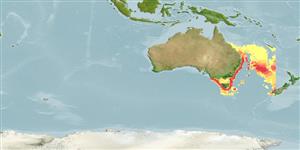Common names from other countries
分類 / Names
俗名 | 同種異名 | Catalog of Fishes(屬, 種) | ITIS | CoL | WoRMS | Cloffa
Teleostei >
Anguilliformes (Eels and morays)
鰻鱺目 (Eels and morays) >
Anguillidae (Freshwater eels)
鰻鱺科 (Freshwater eels)
Etymology: Anguilla: Latin, anguilla, .-ae = eel (Ref. 45335).
More on author: Richardson.
Environment: milieu / climate zone / depth range / distribution range
生態學
海洋; 淡水; 半鹹淡水 底中水層性; 降海洄游 (Ref. 9258); 深度上下限 0 - 3000 m (Ref. 86942). 亞熱帶的; 18°S - 47°S, 140°E - 168°E
Southwest Pacific: east coast of Australia and New Zealand, extending north to New Caledonia. Museum records from Fiji and Tahiti are doubtful. Australian and New Zealand forms sometimes recognized as subspecies. Most easily confused with Anguilla obscura and the surest way of distinguishing them is to count the vertebrae. Reported from Western and American Samoa (Ref. 592).
西南太平洋: 被向北延伸到新加勒多尼亞的澳洲東岸與紐西蘭。 博物館來自斐濟的紀錄,而且大溪地島是可疑的。 澳洲與紐西蘭的型有時被鑑定為亞種。 最容易互相混淆區分他們的 安圭拉 obscura 與最可靠的方法將計算脊椎骨。 記錄來自西薩摩亞與美屬薩摩亞了。 (參考文獻 592)
大小 / 重量 / 年齡
Maturity: Lm ? range ? - ? cm
Max length : 130 cm TL 雄魚/尚未辨別雌雄; (Ref. 40637); 106.5 cm TL (female); common length : 45.0 cm TL 雄魚/尚未辨別雌雄; (Ref. 9258); common length :65 cm TL (female); 最大體重: 7.5 kg (Ref. 40637); 最大年齡: 32 年 (Ref. 6390)
Occurs in streams, lakes and swamps. More likely inhabits slow flowing streams or still waters (Ref. 26509). Feeds on fishes, crustaceans, mollusks, worms, aquatic plants, and terrestrial and aquatic insects. This species does not breed outside its Pacific spawning ground. Migrates to the sea to breed (Ref. 9258). Maximum length for female eel taken from Ref. 6390. Migrating females in Lake Ellesmere (Canterbury, New Zealand) were reported to be in the range of 48.3 to 102.4 cm, larger than for males 33.8 to 55.4 cm (Ref. 44724). Despite its slimy appearance, its flesh is of excellent quality, considered a delicacy in many countries; meat suitable for smoking (Ref. 33839).
出現在溪流,湖與沼澤。 更或許居住於慢的流動溪流或靜止的水域。 (參考文獻 26509) 捕食魚,甲殼動物,軟體動物,蠕蟲,水生植物與陸生與水生昆蟲。 這種不在被產卵地面的它的太平洋的外邊繁殖。 迴游到海洋繁殖。 (參考文獻 9258) 最大的母魚體長鰻魚取自了參考文獻 6390. 不在乎它的黏滑外表,它的肉是有在許多國家中被認為是一個佳餚的優良品質的; 肉適合做煙燻。 (參考文獻 33839)
Life cycle and mating behavior
成熟度 | 繁殖 | 產卵場 | 卵 | 孕卵數 | 仔魚
西南太平洋: 被向北延伸到新加勒多尼亞的澳洲東岸與紐西蘭。 博物館來自斐濟的紀錄,而且大溪地島是可疑的。 澳洲與紐西蘭的型有時被鑑定為亞種。 最容易互相混淆區分他們的 安圭拉 obscura 與最可靠的方法將計算脊椎骨。 記錄來自西薩摩亞與美屬薩摩亞了。 (參考文獻 592)
Allen, G.R., 1989. Freshwater fishes of Australia. T.F.H. Publications, Inc., Neptune City, New Jersey. (Ref. 5259)
IUCN 瀕危狀態 (Ref. 130435)
近危 (NT) ; Date assessed: 06 November 2018
CITES (Ref. 128078)
Not Evaluated
人類使用
漁業: 商業性; 養殖: 商業性; 游釣魚種: 是的
更多資訊
參考文獻養殖養殖資訊品種遺傳學Electrophoreses遺傳率疾病加工Mass conversion
合作者照片Stamps, Coins Misc.聲音神經毒速度泳型鰓區Otoliths腦重體重比眼睛色素
工具
特別的報告
下載 XML
網路資源
Estimates based on models
Preferred temperature (Ref.
115969): 4.3 - 9.1, mean 5.3 (based on 57 cells).
Phylogenetic diversity index (Ref.
82804): PD
50 = 0.5000 [Uniqueness, from 0.5 = low to 2.0 = high].
Bayesian length-weight: a=0.00068 (0.00054 - 0.00085), b=3.16 (3.11 - 3.21), in cm Total Length, based on LWR estimates for this species (Ref.
93245).
營養階層 (Ref.
69278): 4.3 ±0.5 se; based on diet studies.
回復力 (Ref.
120179): 低的, 最小族群倍增時間4.5 - 14 年 (tm=8-30; Fec=3,000,000).
Fishing Vulnerability (Ref.
59153): Very high vulnerability (78 of 100).
